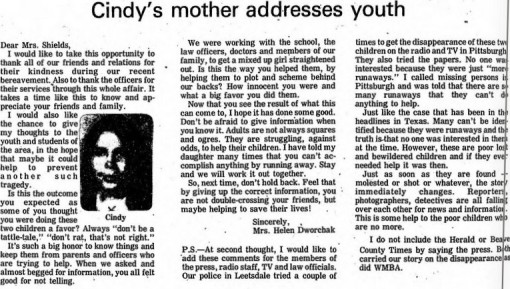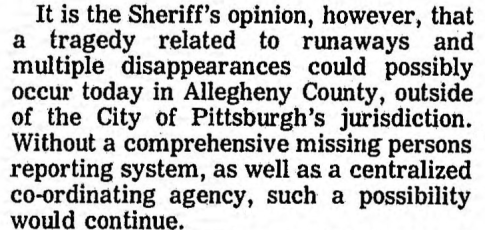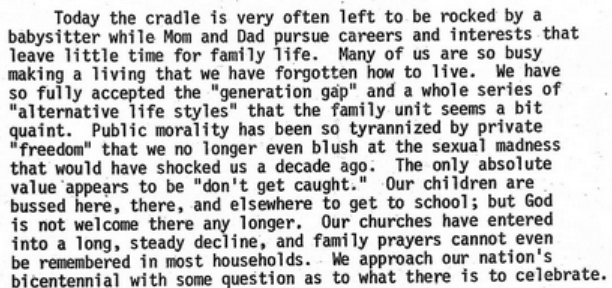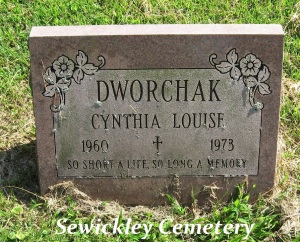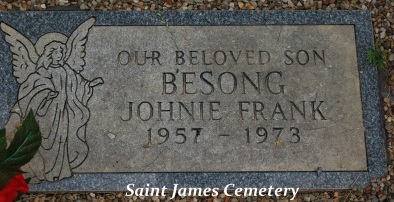Everyone of us who is the parent of a teenage child understands the problems of raising children today. Every vice seems to be hurled at these youngsters. It is almost as though we are wrestling with the Devil himself. Parents everywhere are anxious.
– Betty G.Y. Shields, Editorial, Sewickley Herald, August 29, 1973
Taken on its face, without any date or other references, the above paragraph could apply to any one of the generations of young people that have been brought forth over the last 50 years.
Yet it was during the summer of 1973, 50 years ago this month, that the tragic end to a three month-long mystery brought out emotions uncharacteristic for a small town and its local paper.
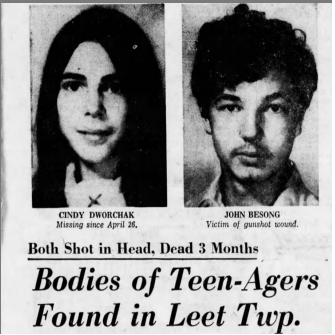
Pittsburgh Post-Gazette, July 31, 1973
The initial media report appeared in the May 16, 1973 Sewickley Herald. John Besong and Cindy Dworchak, both of Leetsdale’s Washington Street neighborhood, were last seen the evening of April 26, after both had attended school that day at Quaker Valley Junior High (now the Middle School).
It was also reported that then-Leetsdale Police chief Michael Poninsky had alerted both the print and broadcast media, and had “put a description on police wires“. What that specifically consisted of is unknown.
Additional Herald reporting indicated that a few sightings of the couple had been reported to authorities, but then slowed to nothing until their skeletal remains were discovered on July 29, 1973 by a man and his son collecting berries in a wooded area between the Davis Road / High Street area of Fair Oaks and the northern fringe of the Quaker Heights development.
The area where they were found was described by the Beaver County Times as “a wooded area about 1,000 yards from the nearest road“. Additional information received from a Leetsdale native via social media provided further insight –
There were two vehicle trails that ran from the “Fair Oaks” (north) end of Quaker Heights Manor along the two ridges north to the power high-line (transmission) towers on those ridges. They were found at the base of the west tower, high above Beaver Road. The two trails ended at the towers.
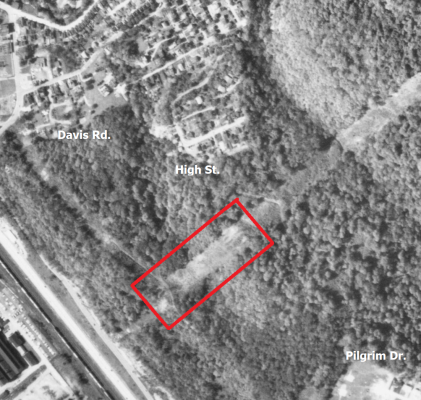
1967 Penn Pilot aerial photo of area where the bodies of John Besong and Cindy Dworchak were found on July 29, 1973. Locations of wooded area around electric line transmission towers is highlighted in red. Click to enlarge – Historic Pittsburgh

3D rendering of same area as seen from the west, taken 2021. The houses immediately south of the area in red were built in the 2000s – this was all wooded area in 1973 (see above photo). Click to enlarge – Google Maps / J. Linko
While the Times and Post-Gazette reports did not speculate on the manner of death, the Herald coverage was the first to quote anyone regarding the possibility that the incident was a murder-suicide. Media reports also indicated that the investigation was being handled by detectives from the Allegheny County Police. When contacted, the agency stated they were unable to locate any case records related to their investigation.
I was going to try to dig deeper to ascertain from relatives and friends what may have motivated these two to leave together. Media accounts stated that the two had a history of running away from home, but offered no greater insight beyond that.
The parents of both Cindy and John are deceased, but their words are part of the historical record to be explored further on. I did reach out to siblings, one of whom was willing to talk about what they could remember, but I elected to forego any further exploration into the motives or perceived mental state of all involved.
I did this out of respect for those touched more closely by these events. I elected to focus more on the community reaction, which was considerable for a small town (as reflected by its media) and played out in the wake of significant national news that may have served to stir already strained emotions into action.
After the coverage in late July the only mention in any print media was Cindy Dworchak’s obituary in the August 15 Herald. The attention level changed significantly with the August 29 edition.
On the editorial page was a letter to the editor from Helen Dworchak, Cindy’s mother. This was followed, on the same page, by B.G. Shields’ editorial as referenced above.
Both women made strong, impassioned observations – Mrs. Dworchak attempts to speak directly to those young people who may have not cooperated with authorities and/or withheld information on the couple’s whereabouts –
Some of you thought you were doing these two children a favor? Always ‘don’t be a tattle-tale’, ‘don’t rat, that’s not right’. It’s such a big honor to know things and keep them from parents and officers who are trying to help. When we asked and almost begged for information, you all felt good for not telling.
She also expressed frustration with Pittsburgh news media that declined to print information about the couple’s disappearance, quoting some outlets as dismissive, stating that Cindy and John were “just runaways” until the situation changed –
Just as soon as they are found – molested or shot or whatever, the story immediately changes. Reporters, photographers, detectives are all falling over each other for news and information!
Along with the timeless observation at the top of this post, Mrs. Shields lamented in hindsight that while her paper did publish information, “we could have done more“. She also continued about the dichotomy of media attention in an atmosphere that encouraged private difficulties to be kept private – regardless of the potential danger –
Had we trusted the first instinct, a call would have been made to the parents to see if we could assist them by printing a picture, but we feared it would embarrass them. Now we realize that Cindy’s family would have welcomed that help. However, some parents would have scolded us for even asking.
Tragedy on a National Scale
Both Mrs. Dworchak and Mrs. Shields made mention of an incident in Texas – Mrs. Shields referred to “the Houston atrocity” – that came to light at about this same time, and may have significantly influenced the manner in which their respective areas of concern were addressed by law enforcement, the media, and other community stakeholders.
Quoting a 2011 Texas Monthly article and related coverage –
On August 8, 1973, the Houston Police Department discovered a 33-year-old man named Dean Corll shot to death at a home where he was staying in Pasadena, a Houston suburb. They were given information that prompted them to search a shed Corll had been renting; a beach at High Island, east of Houston; and a wooded area near Sam Rayburn Reservoir. They eventually discovered the mutilated bodies of 27 boys in what the New York Times called “the largest multiple murder case in United States history.”
This discovery brought reporters and writers from across the nation and the world to Houston, including In Cold Blood author Truman Capote. The investigation revealed that as many as 20 of the young male victims were from the same neighborhood or an adjacent one, and had been reported as missing. Many of these boys were mischaracterized by police at the time as “just runaways“, apparently not a priority to commit a lot of investigative resources to – this despite pleas and protests by anguished parents.
Quoting the Texas Monthly –
Eleven of them had attended the same junior high. How, Capote and everyone else wanted to know, was it possible that so many boys could have been snatched away from one working-class area of Houston, a mere two miles wide and three miles deep, without anyone—police, parents, neighbors, teachers, or friends—snapping to what was happening?
But you have to understand what that time back then was like. There was no FBI Behavioral Science Unit in the early seventies warning citizens of a certain type of killer who went after a particular group of people (like boys)…There weren’t even missing children pictured on the side of milk cartons. As hard as it is for us to understand today, people in 1973 didn’t snap to the idea of a serial killer.
And so many people told (reporter Skip Hollandsworth) that in that era, the general consensus was that there was this rebellion going on among the youth—that many of them wanted to run away and try free love and listen to Janis Joplin and live in communes. A bunch of boys took off from one neighborhood? It was no big deal.
The Herald of August 29 also showed one of the first signs of a regional, if not national shift in priority and attitudes toward missing juveniles in the wake of the Houston tragedy. On the page opposite the comments of Mrs. Dworchak and Mrs. Shields was a report on a change in procedures at the Allegheny County Sheriff’s Office for handling information about missing persons and runaways.
The article reads more like a press release than something written by a reporter, and was likely an attempt by then-Sheriff Eugene L. Coon to get ahead of the issue, at least as far as his agency could in conjunction with the dedicated Missing Persons bureau of the Pittsburgh Police.
It’s also likely that Mrs. Shields chose to include the story in that issue because of its relevance to the local tragedy that appeared to be foremost on her mind.
Sheriff Coon added an additional note of caution –
Translating Outrage into Action
While it seems apparent that the events in Houston and subsequent fallout served as the catalyst for a nexus of change in the approach of police and other government agencies to reports of missing children, it also seems that in death Cindy and John brought the point home for those in positions of responsibility at the local level.
Commentary both directly and indirectly related to the incident continued to appear in the Herald in the weeks following. This included a September 19 letter from the father of John Besong, as well as a full-page ad in the September 12 issue, an open letter to the community from the clergy of St. Stephens Church.
These three ministers sounded familiar themes related to the decline of the social fabric and its impact on the integrity of the family unit –
The letter concluded with a scripture reference from Deuteronomy related to being a living example of God’s commandments to one’s children.
Could this letter have been written today and still remain relevant? Indeed, the times we have lived in since 1973 remind me more of a passage from Ecclesiastes –
8 All things are wearisome,
more than one can say.
The eye never has enough of seeing,
nor the ear its fill of hearing.
9 What has been will be again,
what has been done will be done again;
there is nothing new under the sun.
10 Is there anything of which one can say,
“Look! This is something new”?
It was here already, long ago;
it was here before our time.
11 No one remembers the former generations,
and even those yet to come
will not be remembered
by those who follow them.
Is Information Power, or Just Information?
Fast forward to today, where information about runaways and other missing persons is readily available from both public and private sources, ranging from regular news media coverage to Amber Alerts.
This information is delivered via mobile data networks both secure and very public, and orchestrated by law enforcement at all levels of government, partnered with private organizations such as the National Center for Missing and Exploited Children.
Still, kids are going missing for all manner of reasons. They are featured on TV and various online platforms seemingly every week. Some of them look like little weathered adults, grown up and spent all too soon.
The heightened levels of attention by law enforcement and the media are clearly helping to raise the collective awareness of society to the plight of missing and runaway children far beyond that of 50 years ago.
This awareness is also extended to those segments of our society that seek to prey upon children. This is not limited to runaways (but can certainly be a contributing factor to the runaway problem) and certainly not limited to a criminal element.
While awareness of the scourge of human trafficking is on the rise, so are the struggles of established institutions in the wake of predatory behavior by those placed in a position of trust.
We Are Better Together
The Sewickley area saw more than its share of tragedies involving children in the 1970s. While things certainly have changed – I can’t imagine my granddaughter with the same latitude that I had as a child – the problems that may have manifested themselves in a 50-year old tragedy continue to plague us today.
While our government, schools, and social service infrastructure commit increasing amounts of resources to addressing the impact on children (real or perceived), at the heart of the matter is the realization that there’s no real replacement for the strong, responsive, present, and engaged support of a family unit to teach, listen and set an example of responsible adulthood – regardless of what that unit looks like.
As difficult as it may seem at times, a strong, trusted community of committed citizens can make a significant difference in enhancing the lives and safety of children – regardless of perceived differences.
Even in the face of danger, there should always be a place of safety and trust for children in a society that claims to care for them – regardless of the circumstances.
Enjoy the rest of your summer.
Acknowledgments –
